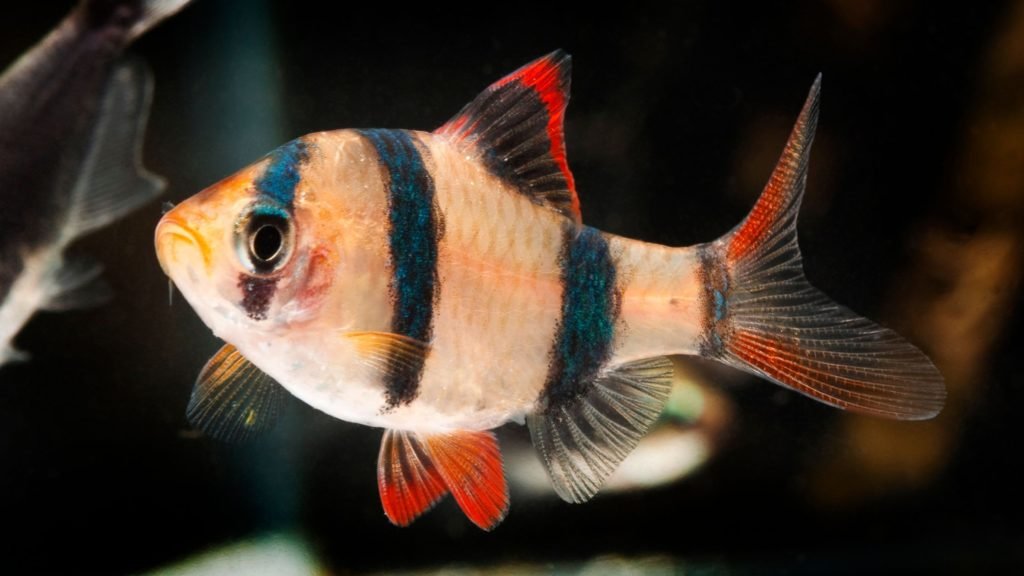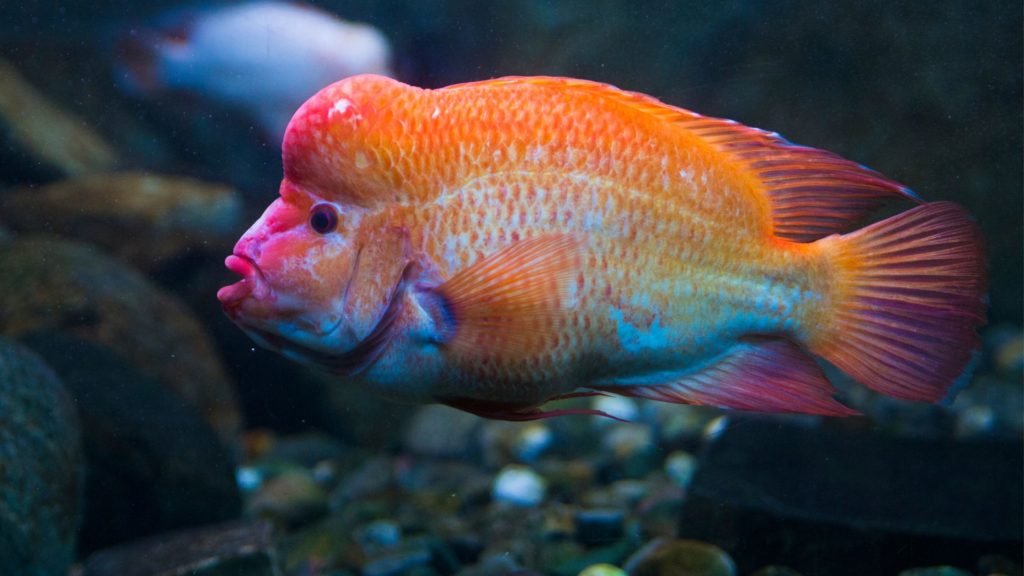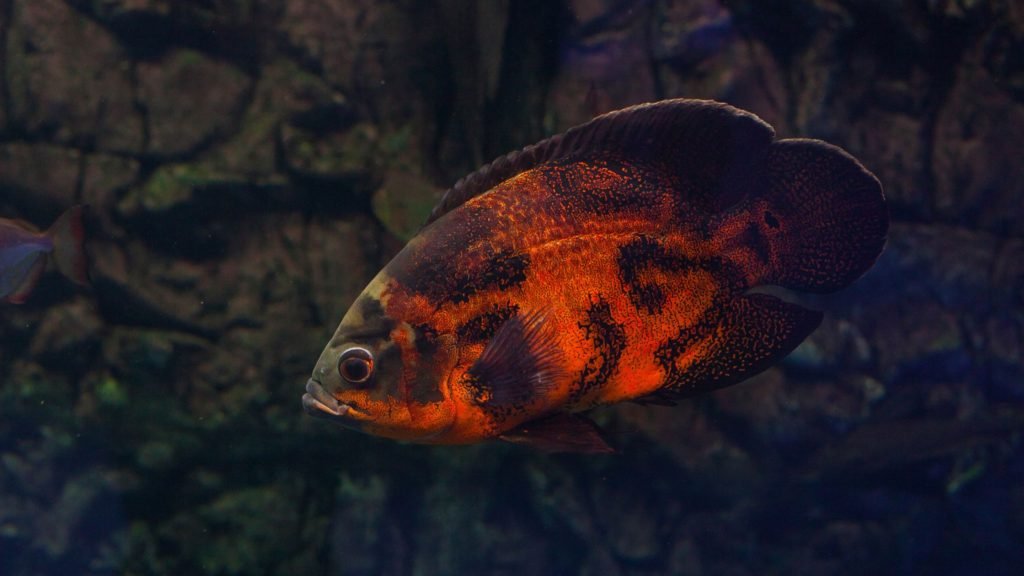Aquariums are a fascinating hobby, bringing the vibrant and diverse life of aquatic ecosystems into our homes. But while most fish live in harmony, some are known for being aggressive. You might wonder, “What is the most aggressive aquarium fish?” and if they can coexist with other fish in your aquarium.
Understanding Aggressive Aquarium Fish Behavior
In the wild, aggression is a natural behavior for many fish species. Animals may behave aggressively due to competition for resources or the protection of their offspring. Just like their wild counterparts, aquarium fish can also exhibit these behaviors.
When we talk about aggressive fish, we usually refer to their tendency to chase, attack, or even kill other fish, especially those of the same species or those that are smaller or slower. Certain species are known to be consistently aggressive, while others may only become aggressive under specific circumstances, such as during breeding or in a cramped aquarium.
Some of the most aggressive aquarium fish come from the Cichlid family. This diverse fish family is known for its bright colors and interesting behaviors, but some are notorious for their aggression. The Red Devil Cichlid, for instance, is infamous for its territorial behavior and willingness to pick fights with other fish.
Most Aggressive Freshwater Aquarium Fish
In freshwater tanks, the most aggressive aquarium fish title is hotly contested. Here are some of the contenders:
Red Devil Cichlid
These bright orange-red fish are known for their territorial behavior. They are incredibly active and often rearrange the tank to their liking, moving smaller rocks and uprooting plants. They won’t hesitate to defend their territory when they feel threatened.
Tiger Barb
While they may be small, Tiger Barbs are notorious fin-nippers. They often chase and nip at the fins of slower-moving or long-finned fish. Although they are generally peaceful when kept in large schools, they can become aggressive when stressed or if kept in smaller numbers.
Wolf Cichlid
Also known as the Dovii or Guapote, this large, predatory cichlid is known for its high levels of aggression. They can grow up to 28 inches and kill fish more significantly than themselves.
Flowerhorn Cichlid
This artificial hybrid is loved for its vibrant colors and the distinctive hump on its head. However, they are also highly territorial and aggressive to other fish.
Convict Cichlids
Named for their vertical black and white stripes, they are one of the easiest cichlids to breed. However, their easy breeding leads to a high level of parental aggression. They will readily attack much larger fish to protect their eggs and fry.
Red-Tailed Black Shark
This freshwater fish is known for its territoriality. It can show aggression towards fish of the same species and smaller fish, especially in cramped tanks.
Oscar Fish
Oscars are large, intelligent, and can become very territorial. They may lash out at other fish encroaching on their space.
Betta Fish
Male Betta fish are famously aggressive to each other. They also attack similar-looking fish, believing them to be rival males.
Wolf Cichlids
One of the largest and most aggressive cichlids, Wolf Cichlids need ample space and a diet rich in protein.
Just because a fish is known for being aggressive doesn’t mean it will always be so. Many factors, including tank conditions, can influence fish behavior.


Traits of the Most Aggressive Saltwater Aquarium Fish
Saltwater aquariums are not exempt from housing aggressive fish. Among the most aggressive saltwater aquarium fish are the Damsel Fish, Triggerfish, and certain species of Eels and Tangs. Their aggression usually stems from a similar source as freshwater fish, including territorial disputes and competition for resources.
Damsel Fish
Despite their attractive appearance and small size, they are known to be very territorial and will often harass and attack other fish that encroach on their space.
Triggerfish
These are notorious for aggression, especially during the breeding season. Their strong jaws and sharp teeth make them a threat to smaller and less aggressive fish.
Moray Eels
Moray Eels can become aggressive if threatened or cornered. Some large species have even been known to attack their owners!
Tangs
Some Tangs, such as the Blue Tang, can be aggressive towards other fish, particularly those of the same species. They can also become aggressive if they do not have enough space to swim.
Again, it’s important to remember that individual behavior can vary greatly. Proper care and suitable living conditions can significantly reduce aggressive behavior.


Why Are Some Aquarium Fish Aggressive?
Fish become aggressive for a few reasons: territorial instincts, competition for resources, and the need to assert dominance. A peaceful fish can become aggressive if stressed due to unacceptable living conditions such as overcrowding, poor water quality, or incompatible tank mates.
Moreover, aggressive fish often live in environments where resources such as food and shelter are scarce or unevenly distributed. This scarcity creates a need to compete for resources and defend territories, leading to aggressive behavior.
Also, hormones can influence fish aggression. Both male and female fish can become more aggressive to protect their offspring during breeding. If you notice a sudden increase in charge, it could be a sign that your fish are spawning.
Dealing with Aggressive Aquarium Fish
If you have aggressive aquarium fish, managing their behavior is essential to ensure the safety and health of all fish in your tank. Here are some ways to handle aggression:
1. Provide Plenty of Space: Overcrowding can lead to stress and increase aggression in fish. A larger tank can alleviate territorial disputes, especially with larger or more territorial species.
2. Create Hiding Spots: Use plants, rocks, and other aquarium decorations to create hiding spots and barriers. These can help less aggressive fish escape if needed and allow multiple territories within the tank.
3. Keep Them in Groups: Some species, like the Tiger Barb, are less likely to be aggressive when kept in large groups, as their aggression gets diffused among the group.
4. Choose Compatible Tank Mates: Some fish species are more capable of handling aggression than others. Fish that are similar in size, speed, and temperament are often a good match.
5. Use a Separate Tank: In extreme cases, it may be necessary to keep aggressive fish in a separate tank to prevent them from injuring other fish.
Preventing Aggression in Your Aquarium
Preventing aggression starts with understanding the needs of your aquarium fish. Selecting fish with compatible temperaments, providing a suitable environment, and meeting their specific needs can help reduce aggressive behavior.
1. Research Before Buying: Understanding a fish’s natural behavior can help you predict its behavior in your tank.
2. Monitor Your Fish: Monitor your fish and their interactions. Early detection of aggression can prevent harm to other fish.
3. Feed Adequately: Hunger can trigger aggression. Make sure you’re providing enough food for all your fish.
4. Regular Water Changes: Clean, healthy water reduces stress and can lower aggression.
Prevention is always the best strategy for dealing with aggressive aquarium fish. Be prepared, know your fish, and always strive to provide the best care possible.
Housing Aggressive Fish: What You Need to Know
If you decide to keep aggressive fish, you need to consider a few things. You’ll need a large enough tank to provide sufficient space for each fish, including territorial ones. Regular monitoring is necessary to ensure all fish are healthy and stress-free. Consider keeping a separate tank for overly aggressive fish, if required.
Additionally, it’s essential to have a well-thought-out plan in emergencies. A hospital tank is a good idea for any aquarium owner, but it’s necessary if you’re keeping aggressive fish. A quiet place to recover can be a lifesaver if a fish gets injured due to aggression.
The Role of Territory in Aquarium Fish Aggression
Territory plays a critical role in fish aggression. In the wild, fish often claim areas for themselves, usually for feeding, mating, or simply as a safe space. In an aquarium, this natural behavior continues, and it can lead to conflict, especially in a small or overcrowded tank.
If a fish feels its territory is being invaded, it might exhibit aggressive behavior. That can include chasing, nipping, and in some cases, physically attacking the perceived intruder. Understanding the territorial needs of your fish can help mitigate such problems.
When setting up your aquarium, consider including multiple hiding spots and areas of interest for your fish. That can reduce territorial disputes and keep aggression levels low. Providing adequate space for each fish is also crucial to maintain a peaceful aquarium environment.
Creating Harmony in an Aquarium with Aggressive Fish
While dealing with aggressive fish can be challenging, it’s not impossible to create a harmonious aquarium. Here are a few tips to consider:
1. Choose Compatible Fish: Research species that can live together peacefully. Some fish may be more tolerant of others, while some aggressive species may ignore fish that don’t resemble their species.
2. Provide Enough Space: Overcrowding can trigger stress and aggression. A spacious tank gives all fish their personal space and reduces territorial disputes.
3. Use Natural Barriers: Plants, rocks, and decorations can create visual barriers and separate territories, reducing the chances of conflicts.
4. Maintain Stable Water Conditions: Regular water changes, proper filtration, and maintaining the right temperature can reduce stress and help keep aggression in check.
5. Monitor Regularly: Keep a close eye on your aquarium. If you notice excessive aggression, you may need to rearrange your tank or move some fish to different tanks.
Frequently Asked Questions
1. Are there any aggressive fish I should avoid as a beginner?
Novice fish owners must avoid aggressive fish that demand specialized care to thrive. That includes but is not limited to diverse Cichlid species, Red-Tailed Black Sharks, and Tiger Barbs.
2. Can aggressive fish live peacefully with other fish?
Aggressive fish can coexist with other fish with careful planning and adequate space. The key is choosing compatible species and providing a suitable environment.
3. Can I reduce fish aggression?
Yes, providing a spacious and enriched environment, keeping compatible fish together, feeding adequately, and maintaining clean water can help reduce aggression in your aquarium.
4. Do aggressive fish need special care?
Some aggressive fish may require larger tanks, specific water conditions, or diets. It’s essential to research each species’ needs before adding them to your aquarium.
Conclusion
So, “What is the most aggressive aquarium fish?” The answer varies depending on the specific species, their living conditions, and their tank mates. However, understanding fish behavior and providing a conducive environment can help manage and reduce aggression in your aquarium.
Related Articles

Dalmatian Molly Behavior: What You Need to Know
Understanding Dalmatian Molly Interactions When we

Is Swordtail Fish Aggressive? Everything You Need to Know
Swordtail fish are popular among aquarists

Explore the Intriguing World of Panda Corydoras Fish
If you’re a fish enthusiast looking

Rasbora Harlequin Fish: A Colorful Addition to Your Aquarium
Have you ever considered adding a

Discover the Best Fish Compatible with Zebra Danios
Find the best fish compatible with

Can Guppy fish live with Goldfish? Discover the Truth
An intriguing question many aquarium enthusiasts

